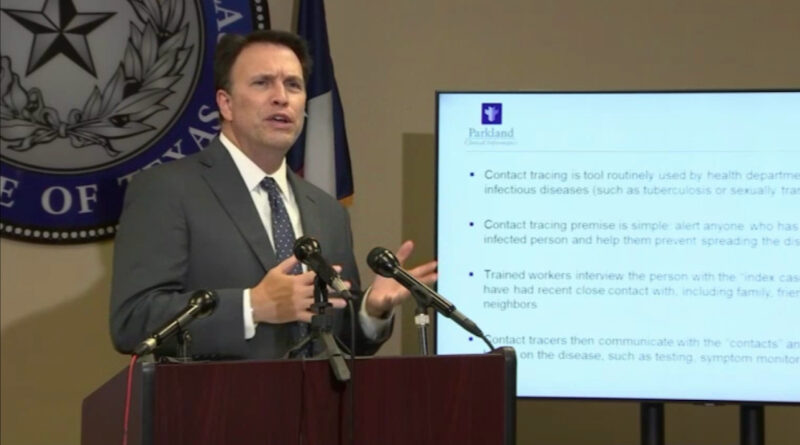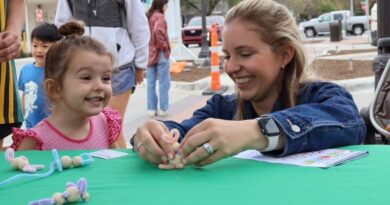Texas Tribune: As COVID-19 Surged, State Contact Tracing Shrunk
Editor’s note: This is republished with permission.
By Emma Platoff
The Texas Tribune
As Texas becomes a national hot spot for the new coronavirus, the state is still falling short on the governor’s months-old goal to employ up to 4,000 contact tracers — and the number of virus detectives dropped recently when the state health agency reassigned hundreds of state workers.
Earlier this month, 400 Texas Department of State Health Services employees who had been temporarily assigned to contact tracing were directed to other roles, including other COVID-19 response jobs, because there were sufficient personnel to track all the cases they were covering, spokesperson Lara Anton said.
Now, about 2,800 contact tracers are at work in Texas, even as the state has routinely reported more than 5,000 new COVID-19 cases each day. In early June, the state’s contact tracing workforce numbered about 2,900, and it reached almost 3,200 later in the month before dropping again.
Anton said the agency still has “enough tracers at the state level to meet our workload, and both we and local health departments continue to add staff.”
In the parts of the state it is covering, she said, DSHS has enough workers to call every person who has a positive test result, as well as their contacts. The agency is also capable of providing “surge capacity” for the many local health departments that are handling the process themselves, Anton said, and the workforce can scale up as needed.
But experts say that a state with 29 million people where cases are climbing at an alarming rate needs as big a workforce as it can muster.
“If you don’t have enough people out there doing [contact tracing], it’s difficult to stay on top of it. It’s kind of like the dam’s being broken open,” said Rodney Rohde, a virologist and epidemiologist at Texas State University.
Even the 4,000 goal, he said, seemed too small in the face of the state’s current outbreak. “It seems to me, with the current case rate, you would want as many as you could possibly get. … It seems like common sense.”
And health officials in some of Texas’ biggest cities — some of whom have already asked the state for assistance — said they are struggling to keep pace with contact tracing as cases skyrocket. Of the state’s 2,800 contact tracers, 1,250 are working in local health departments, Anton said.
“With the increasing numbers that we’ve had, it’s just been overwhelming,” Dr. Philip Huang, director of Dallas County Health and Human Services, said at a news conference last week.
Anton said the state’s workforce can scale up as needed, including by recalling the DSHS employees who were taken off contact tracing. The agency has to balance contact tracing with other COVID-19 response tasks, she said.
“Our goal is to match the contact tracing staff we have to the workload as closely as possible,” Anton said.
Contact tracing, the crucial but time-consuming process of reconstructing a patient’s every move so that people who may have been exposed to the virus can self-isolate, has always been considered an essential component of safely reopening Texas businesses after the statewide restrictions Abbott put in place in the spring. Workers painstakingly retrace a COVID-19 patient’s steps and encourage anyone they may have infected to quarantine. Reaching every contact can take hours or even days.
If the state could test enough Texans, trace the contacts of those who tested positive and persuade those people to stay home, the theory went, the spread of the virus would slow, allowing Texans to slowly and cautiously return to work.
Testing and contact tracing are “the centerpiece of any disease control strategy,” said Dr. Georges Benjamin, executive director of the American Public Health Association.
But May’s manageable upward trend of cases gave way to alarming rises in June after Abbott allowed more and more businesses to reopen. Young people filled newly open bars and restaurants; now COVID-19 patients are beginning to fill Texas hospitals, particularly in hard-hit regions like Houston and the Rio Grande Valley.
“Texas is a really big state, and now you have a really big outbreak,” Benjamin said. On contact tracing, he said, “you’re nowhere near what you need.”
The Association of State and Territorial Health Officials estimated in late April that Texas would need nearly 9,000 contact tracers. George Washington University researchers recently put the figure close to 20,000.
Darlene Bhavnani, an infectious disease epidemiologist who leads a call center at the University of Texas at Austin Dell Medical School with more than 100 contact tracers, said contact tracing is just one part of a strategy that needs to happen in conjunction with widespread testing and self-isolation by people who have been exposed to the virus.
“At whatever scale [tracing] is happening, it’s going to be somewhat effective,” she said. But “it needs to be done in conjunction with other things.”
Since her team began earlier this spring with just a few cases to trace, she said, it has been working to scale up its operation, trimming unnecessary lines from the script, trying to retain more Spanish speakers to cut down on translation time, and halving the number of times someone attempts to call an unresponsive contact from six to three.
Over the last few weeks, as cases in the Austin area have more than doubled to over 8,000, Bhavnani said her team has been “inundated” and began training dozens more people to become contact tracers.
It’s the same story in San Antonio, where the city’s chief of epidemiology, Rita Espinoza, said officials have been “feverishly hiring additional staff and calling in staff from other departments.”
With cases surging, her department has added as many as 70 new workers. Her department recently put in a request for state assistance to hire more contact tracers, but she said she is not sure when that support will come.
“I can’t say if it’s going to be enough,” she said. “It’s hard with the number of cases we are seeing to say how much is going to be enough.”
Problems with testing have complicated contact tracing efforts around the state. In some places, Texans must wait hours for tests — and then days or even weeks for their results. Those delays mean that an infected person could potentially expose more people before contact tracers can even begin their work.
Travis County Judge Sam Biscoe wrote Monday that “our numbers of confirmed positives and the lag time between the testing and the test results have outstripped both our ability to contact trace and the utility in contact tracing.”
To handle cases more efficiently, Dallas public health officials have launched a semi-automated contact tracing system that sends a text message and a survey link to anyone in the county who has tested positive. Those individuals are then prompted to provide contact information for anyone they have been in close contact with recently.
Technology has proved both an asset and an obstacle. Local leaders, including Austin’s interim public health authority, Dr. Mark Escott, said that their efforts have been hindered by incompatibility between the tracing software local officials are using and that used by the state government.
To receive assistance from the state, locals must use the Texas Health Trace software employed at the state level. The platform has been made available to all local departments, but not all of them have begun to use it, Anton said.
And in a state where more than a third of residents speak a language other than English at home, just 112 of the state’s 2,800 contact tracers have indicated that they are Spanish speakers, according to the state heath agency. Tracers who speak only English have access to a translation service that helps reach more individuals, but that could mean each call takes twice as long, experts said.
“It isn’t enough” just to have a translator, said Diana Cervantes, director of the epidemiology program at the University of North Texas Health Science Center, in an interview earlier this year. “To be able to do that effectively … you need to have people who know and understand not just the language but the culture.”
Sarah Champagne contributed to this report.
Disclosure: The University of Texas at Austin and the University of North Texas have been financial supporters of The Texas Tribune, a nonprofit, nonpartisan news organization that is funded in part by donations from members, foundations, and corporate sponsors. Financial supporters play no role in the Tribune’s journalism. Find a complete list of them here.
The Texas Tribune is a nonpartisan, nonprofit media organization that informs Texans — and engages with them – about public policy, politics, government and statewide issues.









